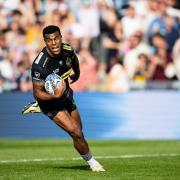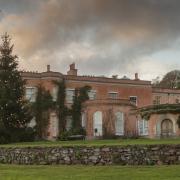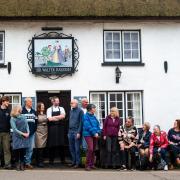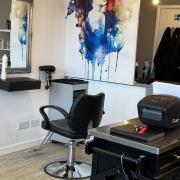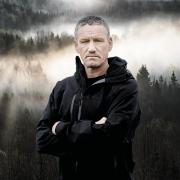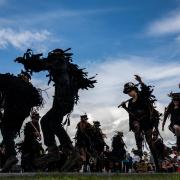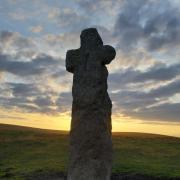Every year the Delamore Estate becomes filled with works of art. The month-long
exhibition attracts legions of fans who will be able to see both indoor and outdoor work by 140 regional, national and international artists. It’s not to be missed.
Respected art writer Estelle Lovatt once commented that if Leonardo da Vinci were alive today, he would be doing what Jonty Hurwitz is doing.
The London-based artist and scientist has received international acclaim for his innovative pieces that combine art, science, mathematics, and engineering to create some of the most remarkable sculpture being made today. His work can be seen in museums and public spaces around the world.
He’s most famous for his three nano sculptures, including in 2014 the world’s smallest figurative sculpture. Modelled by Yifat Davidoff, his life-long partner and creative director of the studio Sentient.art, the sculpture, called Trust, measures 0.1mm. The size of a speck of dust. It requires a one-of-a-kind museum grade microscope to view them, one which they’ve just built following years of development work.
The other pieces that are blowing people’s minds are Jonty’s pioneering catoptric anamorphic sculptures. In these, distorted abstract subjects are reflected onto stainless steel, titanium, or copper cylinders in their true form. Two of these sculptures - Pura Vida and Rosso Horse (both 40cm x 40cm x 50cm) – are at the Delamore Arts and Sculpture Exhibition at Delamore Estate in Cornwood throughout May.

These feats of engineering are made feasible by the combined skills of a huge team, including head of engineering, Graham Walker. Together, the team turns the artistic vision into reality – in this instance, distorted reality: ‘You know that traditional idea of the artist working alone in the studio, this lonely existence of an artist? It’s very different with our pieces,’ says Jonty.
‘On the one hand, it’s an enormous creative journey artistically to come up with the idea, to come up with the original sculptures. But then it’s also a really big logistical journey to make them. There are so many different incredible people that need to be involved in every aspect of the engineering of these pieces. From the metal works to the polishers, to the various components that go into the pieces, to the teams that do the fabrication, and so it’s just this wonderful collaboration of maybe 20 artisans around the country, all putting their hands on it in one way or another.’
The earliest known examples of anamorphic distortion being used in art are sketches by Leonardo da Vinci. To create Jonty’s anamorphic sculptures, it takes billions and sometimes trillions of mathematical calculations. And it’s only now that they can be made because it’s only now that the tools have become available. ‘At any point in history, artistic creations have been connected to the availability of tools and colours of the time,’ explains Jonty, ‘and so the work that’s being exhibited now is contemporary right now to the minute, it uses the latest tools and the latest science and the latest engineering capabilities that are available.
‘But that’s only a part of what it is because the art is also a spiritual journey and a journey of the soul. So, part of it is the science and the wonder of “my God, how’s this made?” But the other aspect is the actual emotional aspect of what’s being given and shared in these pieces.’

This emotion and empathy are at the heart of all Jonty’s sculptures. They tell stories about the people and the creatures that are close to his heart: his mother, his father, Yifat, the frogs he considered as his friends as a child growing up in South Africa but are now at risk, the elephants endangered by hunters, the horses running wild. ‘There’s a part of me that really wants to open up and share. I find myself always landing on lightness, on love, on the environment, on my childhood. I keep coming back to love, so if I have to put my finger on it, I think love is where the ideas come from.’
This is Jonty and Yifat’s first time exhibiting at Delamore Arts which Jonty says is a perfect setting for their work. ‘We’d heard about Delamore and that it’s an incredible space. We just love the open spaces and the open air and sharing in that environment. And I think Delamore really stands out in that world.’
Delamore Arts brings together 140 regional, national, and international artists and sculptors exhibiting some 500 pieces of work inside and in the gardens.
Another internationally renowned sculptor who’s new to Delamore this year is Regis Chaperon, whose striking work is an unusual marriage of origami and stone.

Among the Devon artists making their Delamore debuts is Plymouth painter and illustrator Sarah Smalldon, who’s well-known for her bright, colourful work. At Delamore, she’s showing four acrylics from her ‘on a plate’ series: Lobster on a Plate, Mackerel on a Plate, Oranges on a Plate and Tomatoes on a Plate. Another artist who works with bright colours is Totnes glass artist, Steve Robinson, who will again be delighting visitors with his garden sculptures.
From Dartmoor, there are artists who are inspired by the land, sea, and geology around them. Printmaker Louise Scammell from South Brent has a deep connection with the sea and starts her pieces by drawing underwater using a waterproof sketch pad and then translates her images into print. Sculptor and stonemason Hamish Holman from Hennock says growing up on a working farm on rural Dartmoor is the ‘backbone behind my magnetism towards stone and its permanence within the landscape’. And sculptor, stone carver, and letter cutter Zoe Singleton from Liverton says her work forms ‘the perfect link between art and geology’.
Delamore Arts 2024 is open every day in May, 10.30am to 4.30pm. Admission is £12.50, or £12 if booked online, which is recommended. Under 16s free. Admission includes brochure and parking. The tea-room is open every day serving home-made snacks and cakes.
delamore-art.co.uk





